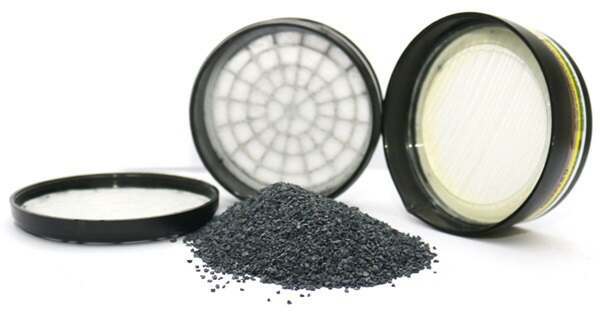Filter types
Choose the right filter and give yourself the best possible protection.
Choose the right filter
It is essential to have the right filter for each task.
- Particulate filters do not provide protection against gases and vapors.
- Gas/vapor filters do not protect against particles.
Particle filter - What is it?
Particles (P) may be smoke particles, dust, liquid mist or microorganisms such as bacteria or viruses. Particle filters remove solid and liquid particles from the air, which are sucked through them. The air resistance and by that the efficiency of the filter increase as the number of particles increases.
There are three types of particulate filters:
- P1 = lowest efficiency rate
- P2 = medium efficiency rate
- P3 = highest efficiency rate
Particulate filter lifetime
When the resistance to breathing becomes uncomfortably high, it usually indicates that the filter needs to be replaced. Therefore, always keep extra filters in stock.
Gas/vapor filter - What is it?
Gas/vapor filters protect against the majority of toxic vapors, as well as organic, inorganic and acidic gases, etc.. The type of chemical you work with is critical in choosing filter classes – and types.
There are three filter classes:
- Class 1 = low capacity
- Class 2 = medium capacity
- Class 3 = high capacity


There are six different filter types:


A
Protects against vapors and gases from organic solvents with a boiling point
above 65˚ C, e.g. VM&P naphta and toluene. Filter type A has a brown color code.


AX
Protects against vapors and gases from organic solvents with a boiling point equal to or below 65˚ C. Filter type AX is only available in one class. AX are single use filters which must be discarded the same day they are used. Filter type AX has a brown color code.


A
+ formaldehyde
Protects against organic vapors from substances with a boiling point above 65˚ C, as specified by the manufacturer, as well as formaldehyde.


B
Protects against inorganic gases and vapors, for example chlorine, hydrogen sulfide and hydrocyanic acid. Filter type B has a gray color code.


E
Protects against acid gases, e.g. sulfur dioxide. Filter type E has a yellow color code.c


K
Protects against vapors and gases from ammonia and certain amines. Filter type K has a green color code.


HgP3
Protects against vapors and gases from mercury and against particles. Hg-P3 filters have a red/white color code.
Filters for several different gases and vapors as well as combinations of particles and gases have color codes for each type.


Activated carbon
Gas/vapor filters contain activated carbon in the form of a few milimeter sized carbon grains. The carbon grains are porous with a very large internal surface to which the gases and vapors can be bonded. However, not all gases and vapors can be bonded sufficiently firmly to the surface of the carbon, which is why some filter types contain activated carbon impregnated with chemicals that can bind or convert the gaseous/vaporous contaminants. The A and AX filter types contain only ordinary pure activated carbon. The filters labeled B, E and HgP3 contain impregnated activated carbon.


Service life of gas/vapor filters
The service life of a gas/vapor filter depends on several factors. What does it protect against? What is the volume of gas/vapor in the air? What is the user's air consumption? What is the air humidity?
These conditions are rarely known with certainty, and can also vary during use, so you usually cannot calculate the service life of a filter in advance. Instead, you can use your sense of smell as a warning, to start with. When you can smell – or taste – what you are working with, the filter no longer protects.
Here is how to make a filter replacement schedule:
When you start using a new filter, note how long it takes before you start to smell something going through the filter. For example, you might use the filter one hour one day, three hours the next day, two hours the third day, etc. If this trial indicates that the filter lasts e.g. 16 hours, your schedule should be for filter replacement after 12 hours of wear. This way, you have added a suitable safety margin of 25%. If you can still smell something before then, of course the filter must be replaced immediately!
